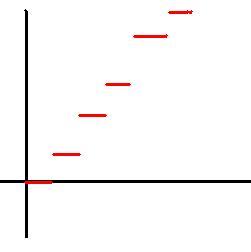y asish s post is not pinked he was rite with graph sir. i also made this graph. pls inform wat is wrong with asish's post.
y = [x]+[x/2]+[x/4]+[x/8]+......[x/2n].... limit n tending to infinity!
-
UP 0 DOWN 0 0 43

43 Answers
y=198(here)
Looks like sumthin to do with binary system coz ther 2 v perform such kind of operations...[7]
sir got an idea
{x}=x x(0,1)
{x}=x-1 x(1,2)
and so on ..............
now in (0,1)
y=3x +x/2 +x/4 ............x/2n where n tends to ∞
=4x
so graph will have a slope of 4 in (0,1)
and in the further manner we could proceed to make the whole graph
i hope this was what u expecting
sir
one thing i know is that y= -∞ for x<0
For x>0,
x ε [0,1) y=0
x ε [1,2) y=1
x ε [2,3) y=3
x ε [3,4) y=4
x ε [4,5) y=7
x ε [5,6) y=8
.
.
.
.
for x ε [2n,2n+1) y=2n+1-1
for x ε [any odd number,that odd number + 1), y=yprevious even number + 1
This was all i could get......
the gaps are at varying heights....
Also for x ε [every multiple of 2n but not of any further power of 2,every multiple of 2n but not of any further power of 2 + 1) y= yprevious number + (n+1)
For example for x ε [3*25,3*25 +1) y=yof 3*25-1 + 6
good work ashish.. this is a good way to look at it.
there are too many complexities as we go to higher numbers....
but this was only to show how a simple looking function could end up being that complex.
I felt sad that not many of you could notice that the value will be constant between integers!!
SIR WHAT IS THE FLAW WITH MY EXPLAINATION
{x}=x x(0,1)
{x}=x-1 x(1,2)
and so on ..............
now in (0,1)
y=3x +x/2 +x/4 ............x/2n where n tends to ∞
=4x
so graph will have a slope of 4 in (0,1)
and in the further manner we could proceed to make the whole graph
i hope this was what u expecting
sir
@manipal. take any value in (0,1) say 0.5, then [0.5]=0 and subsequent terms is also zero. hence y=0.
sir can modyfy it a little bit so that sandwich theorm can be applied[3]
there are many more complexities to this one... see a larger number say 21.. what will be the answer? will it satisfy ashish's expression? 21+10+5+2+1=39 22+11+5+2+1=41 29+14+7+3+1=54 I dont see his formula satisfying everything!
His attempt was good no doubt.
Hint: take the binary expansion of the whole number!
sorry i meant
binary representation of the decimal number
10101 = 1 + 4 + 16 = 21
so every number can be represented as
2a + 2b + 2c + ....
now does this expression help?
#25 Posted 11:12am 23-02-09
Re: Daily Graph 22-02-09
y=198(here)
"Looks like sumthin to do with binary system coz ther 2 v perform such kind of operations..."
may b u didnt notice this post!!!
I was tokin of da same binary thing......
though i still am not convinced that the function will be constant b/w the integral values....
but anyways if it is then what else has to be done bhaiyya
can't we write
y = [x] + [log2( [x]!)] [7]
hehe lots of [.]..[4]
bhaiyya which formula were u talking abt of mine that didnt work in above posts?
tapan bhai main yeh nahin keh raha ki graph aage nahin hai
maine to eg diya tha
actually its quite complex to cover the whole story
[x] = x - {x}
so this becomes x + x/2 .... - ({x} + {x/2} ........)
x ( 1 + 1/2 + 1/4 + ........... 1/2n) = 2x ( using geometric mean )
and so far as fractional part of x concerns it will always lie between 0 to 1
so rough idea of the graph is
it is 0 from 0 to 1
and should be discontinuous as well as straight line
further help needed???
jus a lil addtn : da formula i was tellin starts wid [x/2] baki sab same hein